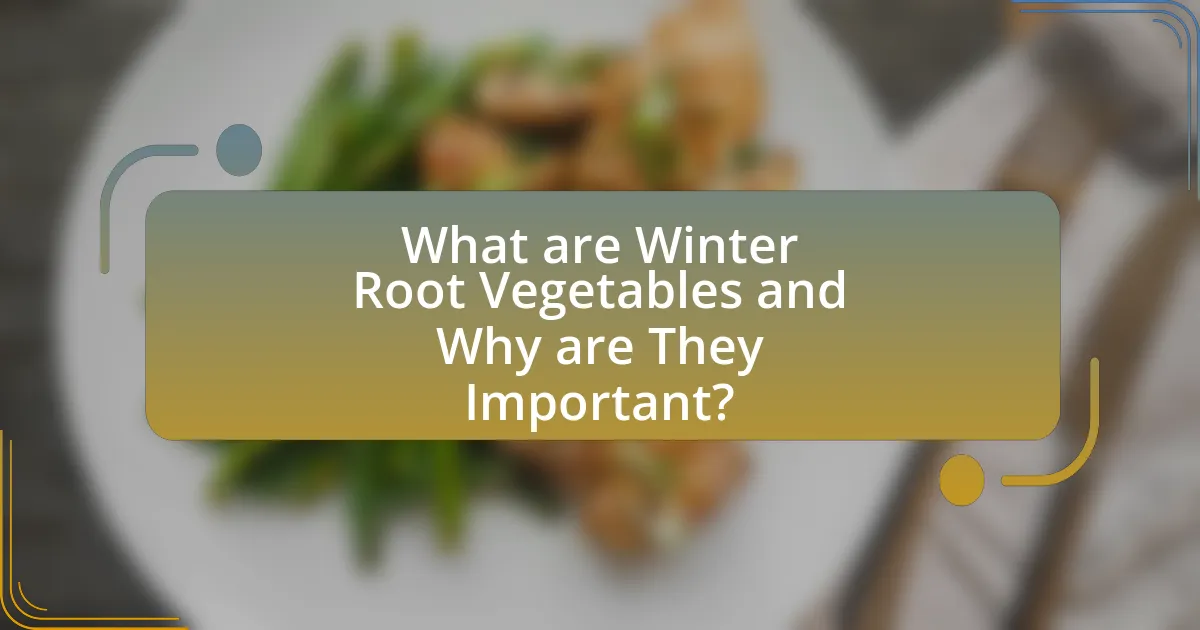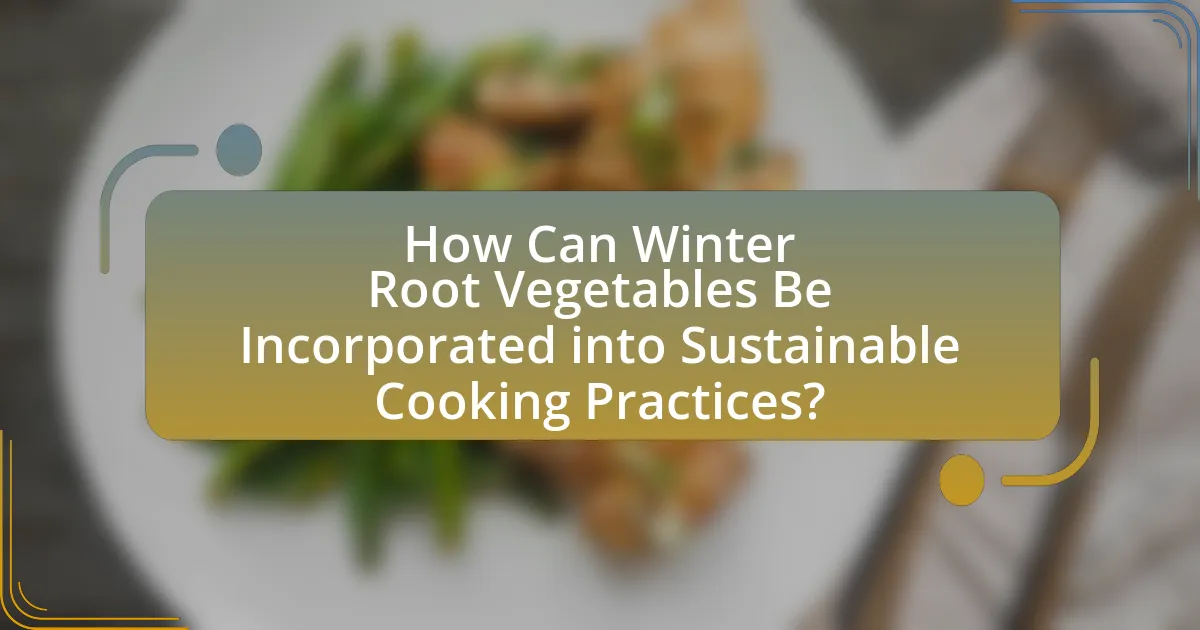Winter root vegetables, including carrots, parsnips, turnips, and beets, are essential components of a sustainable diet due to their high nutritional value and resilience in colder months. This article explores their significant health benefits, such as providing essential vitamins, minerals, and dietary fiber that support immune function, digestive health, and weight management. It also discusses the environmental advantages of incorporating these vegetables into cooking practices, emphasizing their role in reducing food waste and carbon footprints. Additionally, various culinary applications and storage methods are highlighted to maximize their nutritional benefits and enhance sustainability in cooking.

What are Winter Root Vegetables and Why are They Important?
Winter root vegetables are edible plants that grow underground and are harvested during the colder months, including varieties such as carrots, parsnips, turnips, and beets. These vegetables are important because they provide essential nutrients, such as vitamins A and C, potassium, and dietary fiber, which support immune function and digestive health. Additionally, winter root vegetables are resilient crops that can be stored for extended periods, reducing food waste and promoting sustainability in cooking practices. Their versatility in various culinary applications further enhances their significance in a balanced diet during winter months.
What types of winter root vegetables are commonly used in cooking?
Commonly used winter root vegetables in cooking include carrots, parsnips, turnips, beets, and rutabagas. These vegetables are rich in nutrients and are often harvested in colder months, making them staples in winter cuisine. For instance, carrots are high in beta-carotene, while beets provide essential vitamins and minerals. Their versatility allows for various cooking methods, such as roasting, boiling, and mashing, which enhances their flavors and nutritional profiles.
How do different winter root vegetables vary in nutritional content?
Different winter root vegetables vary significantly in nutritional content, with each type offering unique vitamins, minerals, and fiber. For instance, carrots are high in beta-carotene, which converts to vitamin A, while beets provide folate and manganese. Sweet potatoes are rich in vitamin C and potassium, and parsnips contain a good amount of dietary fiber and vitamin K. According to the USDA FoodData Central, a medium carrot contains about 25 calories and 6 grams of carbohydrates, while a medium sweet potato has approximately 112 calories and 26 grams of carbohydrates. This variation in nutritional profiles allows for diverse health benefits when incorporating these vegetables into a diet.
What are the seasonal availability and sourcing options for winter root vegetables?
Winter root vegetables, including carrots, parsnips, turnips, and beets, are typically available from late fall through early spring, with peak harvest occurring in winter months. These vegetables can be sourced from local farmers’ markets, grocery stores, and community-supported agriculture (CSA) programs, which often provide fresh, seasonal produce directly from local farms. The USDA reports that many root vegetables can be stored for extended periods, allowing for availability even after the harvest season. This storage capability enhances their accessibility throughout winter, making them a reliable option for sustainable cooking.
Why should we consider winter root vegetables in sustainable cooking?
Winter root vegetables should be considered in sustainable cooking because they are nutrient-dense, locally available, and have a lower environmental impact compared to imported produce. These vegetables, such as carrots, beets, and turnips, are rich in vitamins, minerals, and fiber, contributing to a balanced diet. Additionally, they can be stored for long periods, reducing food waste and reliance on out-of-season crops. Studies indicate that consuming seasonal and locally grown foods can significantly decrease carbon footprints, as transportation emissions are minimized. Therefore, incorporating winter root vegetables into cooking not only supports health but also promotes environmental sustainability.
How do winter root vegetables contribute to a sustainable diet?
Winter root vegetables contribute to a sustainable diet by providing nutrient-dense food options that require less energy and resources to grow compared to many other crops. These vegetables, such as carrots, beets, and turnips, are typically grown in cooler climates and can be harvested late into the season, reducing the need for energy-intensive greenhouse production. Additionally, they often have a longer shelf life, which minimizes food waste and allows for storage without refrigeration. Studies indicate that root vegetables can be cultivated with fewer pesticides and fertilizers, further enhancing their sustainability profile. Their ability to thrive in diverse soil conditions also supports agricultural biodiversity, which is crucial for resilient food systems.
What environmental benefits are associated with growing winter root vegetables?
Growing winter root vegetables provides several environmental benefits, including improved soil health, reduced carbon footprint, and enhanced biodiversity. These vegetables, such as carrots and beets, are typically grown in colder months, which helps to prevent soil erosion and maintain soil structure due to their deep root systems. Additionally, winter root vegetables require less water and fewer chemical inputs compared to other crops, leading to lower resource consumption and reduced pollution. Research indicates that cultivating these crops can also support local ecosystems by providing habitats for beneficial insects and promoting a diverse agricultural landscape.

What Nutritional Benefits Do Winter Root Vegetables Offer?
Winter root vegetables offer significant nutritional benefits, including high fiber content, essential vitamins, and minerals. These vegetables, such as carrots, parsnips, and beets, are rich in dietary fiber, which aids digestion and promotes gut health. They also provide vital nutrients like vitamin C, which supports the immune system, and potassium, which helps regulate blood pressure. Additionally, many winter root vegetables contain antioxidants, such as beta-carotene in carrots, which can reduce the risk of chronic diseases. The combination of these nutrients makes winter root vegetables a valuable addition to a balanced diet, particularly in sustainable cooking practices that emphasize seasonal and locally sourced ingredients.
How do winter root vegetables support overall health?
Winter root vegetables support overall health by providing essential nutrients, fiber, and antioxidants that contribute to various bodily functions. These vegetables, such as carrots, beets, and turnips, are rich in vitamins A and C, potassium, and dietary fiber, which promote immune function, digestive health, and cardiovascular health. For instance, a study published in the Journal of Nutrition found that the high fiber content in root vegetables can help lower cholesterol levels and improve gut health. Additionally, the antioxidants found in these vegetables help combat oxidative stress, reducing the risk of chronic diseases.
What vitamins and minerals are abundant in winter root vegetables?
Winter root vegetables are abundant in vitamins A, C, and several B vitamins, as well as minerals such as potassium, magnesium, and iron. These vegetables, including carrots, parsnips, and beets, provide essential nutrients that support immune function, promote healthy skin, and contribute to overall well-being. For instance, carrots are particularly high in vitamin A, which is crucial for vision and immune health, while beets are rich in potassium, which helps regulate blood pressure.
How do the fiber content and antioxidants in winter root vegetables benefit digestion?
The fiber content and antioxidants in winter root vegetables significantly benefit digestion by promoting regular bowel movements and reducing inflammation in the digestive tract. Fiber adds bulk to the stool, which helps prevent constipation and supports a healthy gut microbiome. Antioxidants, such as flavonoids and phenolic acids found in these vegetables, can reduce oxidative stress and inflammation, further enhancing digestive health. Studies have shown that a diet rich in fiber can lower the risk of gastrointestinal disorders, while antioxidants contribute to overall gut health by protecting cells from damage.
What specific health conditions can be improved by consuming winter root vegetables?
Consuming winter root vegetables can improve specific health conditions such as digestive issues, cardiovascular health, and immune function. These vegetables, including carrots, beets, and turnips, are high in dietary fiber, which aids digestion and promotes gut health. Additionally, their rich content of antioxidants and vitamins, particularly vitamin C and potassium, supports heart health by regulating blood pressure and reducing cholesterol levels. Furthermore, the immune-boosting properties of these vegetables, attributed to their vitamins and minerals, enhance the body’s ability to fight infections.
How can winter root vegetables aid in weight management?
Winter root vegetables can aid in weight management by providing low-calorie, nutrient-dense options that promote satiety. These vegetables, such as carrots, turnips, and beets, are high in fiber, which helps to regulate appetite and reduce overall calorie intake. For instance, a medium carrot contains about 25 calories and provides 2 grams of fiber, contributing to a feeling of fullness without adding significant calories. Additionally, the vitamins and minerals found in winter root vegetables support metabolic health, further assisting in weight management efforts.
What role do winter root vegetables play in managing blood sugar levels?
Winter root vegetables play a significant role in managing blood sugar levels due to their low glycemic index and high fiber content. These vegetables, such as carrots, beets, and turnips, release glucose slowly into the bloodstream, preventing spikes in blood sugar. Research indicates that the fiber in these vegetables aids in digestion and promotes a feeling of fullness, which can help regulate overall carbohydrate intake. For instance, a study published in the Journal of Nutrition found that diets rich in high-fiber foods, including root vegetables, are associated with improved glycemic control in individuals with diabetes. Thus, incorporating winter root vegetables into meals can be an effective strategy for blood sugar management.

How Can Winter Root Vegetables Be Incorporated into Sustainable Cooking Practices?
Winter root vegetables can be incorporated into sustainable cooking practices by utilizing local and seasonal produce, minimizing food waste, and employing energy-efficient cooking methods. These vegetables, such as carrots, parsnips, and turnips, are often grown in colder climates and can be harvested throughout winter, reducing the carbon footprint associated with transportation. Cooking methods like roasting or steaming require less energy compared to boiling, further enhancing sustainability. Additionally, using the entire vegetable, including peels and tops, contributes to waste reduction and maximizes nutritional benefits, as many nutrients are concentrated in these parts. This approach not only supports local agriculture but also promotes a healthier diet rich in vitamins and minerals.
What are some popular cooking methods for winter root vegetables?
Popular cooking methods for winter root vegetables include roasting, steaming, boiling, and mashing. Roasting enhances their natural sweetness and caramelizes the sugars, while steaming preserves nutrients and texture. Boiling is a quick method that can soften root vegetables for soups or purees, and mashing creates a creamy side dish. These methods are widely used due to their ability to highlight the flavors and nutritional benefits of root vegetables, which are rich in vitamins and minerals essential for winter diets.
How can roasting enhance the flavors of winter root vegetables?
Roasting enhances the flavors of winter root vegetables by caramelizing their natural sugars, resulting in a sweeter and more complex taste profile. The high heat of roasting causes the Maillard reaction, which not only deepens the color but also intensifies the savory flavors through the development of new compounds. For example, carrots and parsnips, when roasted, can exhibit a rich, nutty flavor that is less pronounced when consumed raw or boiled. This method also helps to retain nutrients, as the cooking process minimizes water-soluble vitamin loss compared to boiling.
What are the benefits of using winter root vegetables in soups and stews?
Winter root vegetables provide numerous benefits when used in soups and stews, including enhanced flavor, nutritional value, and sustainability. These vegetables, such as carrots, parsnips, and turnips, are rich in vitamins, minerals, and dietary fiber, which contribute to overall health. For example, carrots are high in beta-carotene, which supports eye health, while parsnips offer significant amounts of vitamin C and potassium. Additionally, winter root vegetables are often locally sourced and in season during colder months, reducing the carbon footprint associated with transportation. Their natural sweetness and hearty texture also improve the taste and consistency of soups and stews, making them more satisfying and nutritious.
What are some creative recipes featuring winter root vegetables?
Creative recipes featuring winter root vegetables include roasted root vegetable medley, where carrots, parsnips, and sweet potatoes are tossed with olive oil, herbs, and roasted until caramelized. Another option is a root vegetable soup, blending beets, turnips, and potatoes with vegetable broth and spices for a hearty dish. Additionally, a winter root vegetable gratin layers thinly sliced rutabaga, carrots, and potatoes with cream and cheese, baked until golden. These recipes highlight the versatility and nutritional benefits of winter root vegetables, which are rich in vitamins and minerals, making them ideal for sustainable cooking.
How can winter root vegetables be used in salads for added nutrition?
Winter root vegetables can be used in salads to enhance nutrition by providing essential vitamins, minerals, and fiber. These vegetables, such as carrots, beets, and parsnips, are rich in nutrients like vitamin A, potassium, and antioxidants, which support overall health. For instance, a study published in the Journal of Agricultural and Food Chemistry highlights that beets contain betalains, which have anti-inflammatory properties. Incorporating these vegetables into salads can be done by roasting or shredding them, adding texture and flavor while boosting the nutritional profile of the dish.
What are some innovative ways to incorporate winter root vegetables into desserts?
Innovative ways to incorporate winter root vegetables into desserts include using roasted sweet potatoes or carrots in cakes and muffins, blending parsnips into creamy puddings, and creating spiced beetroot brownies. These methods leverage the natural sweetness and texture of the vegetables, enhancing flavor profiles while adding nutritional value. For example, sweet potatoes are rich in beta-carotene and fiber, making them a healthy alternative to traditional dessert ingredients. Additionally, beetroot contains antioxidants and can provide a vibrant color to baked goods, appealing to both taste and presentation.
What tips can help maximize the nutritional benefits of winter root vegetables?
To maximize the nutritional benefits of winter root vegetables, it is essential to cook them using methods that preserve their vitamins and minerals, such as steaming or roasting rather than boiling. Steaming retains more nutrients compared to boiling, which can cause water-soluble vitamins to leach out. Additionally, consuming these vegetables with healthy fats, like olive oil, enhances the absorption of fat-soluble vitamins A, D, E, and K found in root vegetables. Research indicates that cooking methods like roasting can also increase the availability of certain antioxidants, making them more beneficial for health.
How should winter root vegetables be stored to maintain freshness?
Winter root vegetables should be stored in a cool, dark, and humid environment to maintain freshness. Ideal storage conditions include a temperature range of 32°F to 40°F (0°C to 4°C) with high humidity levels, which can be achieved by placing them in a perforated plastic bag or a container with damp sand. This method helps to prevent moisture loss and decay, ensuring that vegetables like carrots, turnips, and beets remain crisp and flavorful for an extended period. Studies show that proper storage can significantly extend the shelf life of these vegetables, preserving their nutritional value and taste.
What are the best practices for preparing winter root vegetables to retain nutrients?
To retain nutrients in winter root vegetables, it is essential to minimize cooking time and use methods such as steaming or roasting instead of boiling. Steaming preserves water-soluble vitamins, while roasting enhances flavor without significant nutrient loss. Additionally, cooking with the skin on helps retain nutrients, as many vitamins and minerals are concentrated in or just beneath the skin. Research indicates that overcooking can lead to a loss of up to 50% of certain nutrients, particularly vitamin C and B vitamins. Therefore, using shorter cooking times and appropriate methods is crucial for maximizing the nutritional benefits of winter root vegetables.


